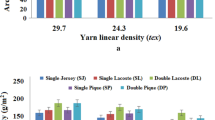Abstract
Knitwear fabrics are now becoming an ultimate choice of clothing consumers because of their easiness in wearing, simplicity, lasting appearance and mechanical distinctiveness. It is necessary to further improve the quality of knitted fabrics to keep their competitive edge in clothing industry. In this research work, knitted vest fabrics were developed with improved thermal resistance and overall moisture management properties. Thermolite yarns of three different counts (linear density) were used to develop the interlock knitted fabrics. Thermal regulation and mechanical properties of developed fabrics were compared with 100% cotton-knitted vest. The study concludes that the use of Thermolite yarns have significantly improved the overall comfort properties of interlock knitted fabrics. The use of Thermolite technology can be an ultimate choice of fabric manufacturers in the development of all seasoned knitted fabric vest compared with cotton.










Similar content being viewed by others
References
Das A, Alagirusamy R. Science in clothing comfort. New Delhi: WPI Publishing; 2010.
Slater K. Human comfort. Springfield: CC Thomas; 1985.
Shin Y, Yoo DI, Son K. Development of thermoregulating textile materials with microencapsulated phase change materials (PCM). IV. Performance properties and hand of fabrics treated with PCM microcapsules. J Appl Polym Sci. 2005;97(3):910–5. https://doi.org/10.1002/app.21846.
Bo-an Y, Yi-Lin K, Yi L, Chap-Yung Y, Qing-wen S. Thermal regulating functional performance of PCM garments. Int J Cloth Sci Technol. 2004;16(1/2):84–96. https://doi.org/10.1108/09556220410520388.
Fan J, Cheng X-Y. Heat and moisture transfer with sorption and phase change through clothing assemblies: part I: experimental investigation. Text Res J. 2005;75(2):99–105. https://doi.org/10.1177/004051750507500202.
Fan J, Cheng X-Y. Heat and moisture transfer with sorption and phase change through clothing assemblies: part II: theoretical modeling, simulation, and comparison with experimental results. Text Res J. 2005;75(3):187–96. https://doi.org/10.1177/004051750507500202.
Manshahia M, Das A. Comfort characteristics of knitted active sportswear: liquid water transportation. Res J Text Appar. 2013;17(3):38–49. https://doi.org/10.1108/RJTA-17-03-2013-B005.
Varshney R, Kothari V, Dhamija S. A study on thermophysiological comfort properties of fabrics in relation to constituent fibre fineness and cross-sectional shapes. J Text Inst. 2010;101(6):495–505. https://doi.org/10.1080/00405000802542184.
Firgo H, Suchomel F, Burrow T. Tencel® high performance sportswear. Lenzinger Berichte. 2006;85:44–50.
Lizák P, Mojumdar SC. Influence of the material structure on the thermal conductivity of the clothing textiles. J Therm Anal Calorim. 2015;119(2):865–9.
Ismail M, Ammar A, El-Okeily M. Heat transfer through textile fabrics: mathematical model. Appl Math Model. 1988;12(4):434–40.
Siddiqui MOR, Sun D. Conjugate heat transfer analysis of knitted fabric. J Therm Anal Calorim. 2017;129(1):209–19.
Washing TD. Drying procedures for textile testing. ISO 6330-2000. 2000.
El-Tarfawy S, editor. Study the relation between the yarn pulling force and the bursting strength of single jersey knitted fabric. IOP conference series: materials science and engineering; 2017: IOP Publishing.
Onofrei E, Rocha AM, Catarino A. The influence of knitted fabrics’ structure on the thermal and moisture management properties. J Eng Fabrics Fibers. 2011;6(4):155892501100600403.
Debnath S, Madhusoothanan M. Thermal insulation, compression and air permeability of polyester needle-punched nonwoven. Indian J Fiber Text. 2010;35(1):38–44.
Senthilkumar P, Kantharaj M, Vigneswaran C. Thermal comfort characteristics of plain woven fabrics. J Text Assoc. 2010;71:188–95.
Barauskas R, Valaseviciute L, Jureviviute A. Computational analysis and experimental investigation of heat and moisture transfer in multilayer textile package. Mater Sci. 2009;15(1):80–85.
Kobiela-Mendrek K, Marcinkowska E. Kinetics of humidification and drying clothing microclimate in simulating researches. Fibres Text Eastern Eur. 2007;15(5–6).
Keiser C, Becker C, Rossi RM. Moisture transport and absorption in multilayer protective clothing fabrics. Text Res J. 2008;78(7):604–13. https://doi.org/10.1177/0040517507081309.
Hes L, Dolezal I. New method and equipment for measuring thermal properties of textiles. Sen’i Kikai Gakkaishi J Text Mach Soc Jpn. 1989;42(8):T124–8. https://doi.org/10.4188/transjtmsj.42.8_T124.
Bedeloglu A. Investigation of electrical, electromagnetic shielding, and usage properties of woven fabrics made from different hybrid yarns containing stainless steel wires. J Text Inst. 2013;104(12):1359–73. https://doi.org/10.1080/00405000.2013.806049.
Kuvandykova D, St-Laurent R. Application of the modified transient plane source technique in testing the thermal conductivity of concrete. C Therm Technol. 2010;18:1–7.
OS A. MTPS—C-therm—thermal conductivity instruments. 2018.
Jamshaid H, Mishra R, Novak J. End use performance characterization of unconventional knitted fabrics. Fibers Polym. 2015;16(11):2477–90. https://doi.org/10.1007/s12221-015-5466-8.
Badr AA, Hassanin A, Moursey M. Influence of Tencel/cotton blends on knitted fabric performance. Alex Eng J. 2016;55(3):2439–47. https://doi.org/10.1016/j.aej.2016.02.031.
Rego JM, Verdu P, Nieto J, Blanes M. Comfort analysis of woven cotton/polyester fabrics modified with a new elastic fiber, part 2: detailed study of mechanical, thermo-physiological and skin sensorial properties. Text Res J. 2010;80(3):206–15. https://doi.org/10.1177/0040517508099910.
Author information
Authors and Affiliations
Corresponding author
Additional information
Publisher's Note
Springer Nature remains neutral with regard to jurisdictional claims in published maps and institutional affiliations.
Rights and permissions
About this article
Cite this article
Masood, R., Jamshaid, H. & Khubaib, M.A. Development of knitted vest fabrics for human body thermoregulation. J Therm Anal Calorim 139, 159–167 (2020). https://doi.org/10.1007/s10973-019-08430-2
Received:
Accepted:
Published:
Issue Date:
DOI: https://doi.org/10.1007/s10973-019-08430-2



